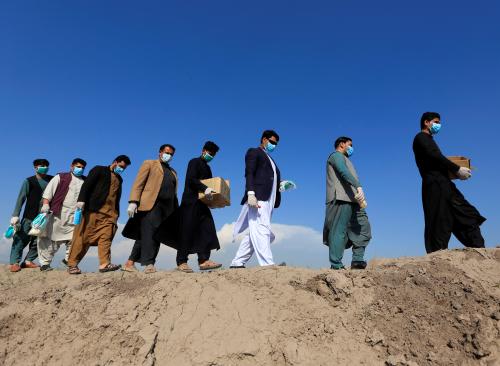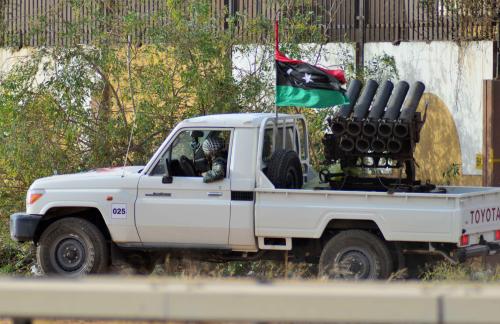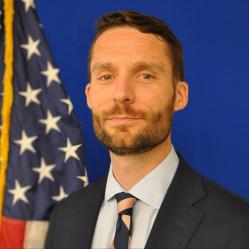The Biden administration will face a multiplicity of challenges on day one. Armed conflict and instability in countries that matter for U.S. interests will be chief among them. From Ethiopia to the Northern Triangle (Guatemala, Honduras, El Salvador), armed violence remains an unfortunately pervasive and persistent element of the national security threat landscape. Intra-state violence had already been rising before the pandemic began its global sweep, but COVID-19 has exacerbated many factors underlying fragility and associated instability.
The Biden administration has an opportunity to address this challenge by effectively implementing the first-ever “U.S. Strategy to Prevent Conflict and Promote Stability.” Released by the national security agencies on December 18, the strategy is the foundational requirement of the bipartisan 2019 Global Fragility Act (GFA), envisioned as a PEPFAR-for-conflict-prevention.
This initiative will be piloted in at least five priority fragile countries over the next decade. It presents an opportunity to test, study, and refine how the U.S. government can partner with communities and governments in fragile states to address the drivers of conflict, such as human rights abuses, social and economic exclusion, corruption, and impunity. It has the potential to realign U.S. diplomatic, development, and defense efforts in a way that reduces instability in countries that are at risk of violent conflict and extremism, as well as strategically important to U.S. efforts to counter China, Russia, and Iran.
The incoming Biden administration should seize the GFA’s statutory authority and build on this new strategy, as well as the 2018 Stabilization Assistance Review, to advance the president-elect’s commitment to American leadership on democracy and human rights.
Violence and U.S. national security: COVID-19 as conflict accelerant
Beyond its devastation to public health, COVID-19 is leaving communities more vulnerable to violence and conflict. Initial analysis of the secondary impacts of the pandemic shows that some of the most severe and lasting impacts will be those on global hunger, poverty, gender equality, and sustainable peace. We are already witnessing how the pandemic is fraying trust, proliferating disinformation, expanding the influence of armed and violent extremist groups, and increasing resource competition.
One recent study projected that COVID-19 will ignite conflict in 13 more countries by 2022, and the Global Humanitarian Overview 2021, released by the United Nations last month, projects that the number of people in need of humanitarian assistance and protection will skyrocket to 235 million — 1 in every 33 people globally — and that conflict is now the main driver of global displacement and hunger. These threats amplify the urgency of effectively implementing the Global Fragility Act and broader importance of addressing violent conflict to safeguard U.S. interests.
Getting implementation right from the start
Now that the Global Fragility Strategy has been released comes the hard part of selecting the priority countries and executing this vision: in Washington, through inter-agency coordination and, more importantly, overseas in the chosen priority countries. The Biden administration should do three things to maximize the strategy’s efficacy and advance its broader democracy assistance and conflict prevention agenda.
First, the Biden team should move quickly to build multilateral support for conflict prevention and stabilization. The Stabilization Assistance Review recommended developing more effective donor coordination platforms to ensure “our partners co-invest with purpose in line with mutually agreed strategic outcomes.” The Global Fragility Act can help advance this approach. The law authorizes a Multi-Donor Global Fragility Fund “to leverage, receive, coordinate, and program funds provided by other donors and private sector partners to carry out the purposes” of the GFA. The FY21 Appropriations Act provides $25 million in seed funding to launch that new fund.
The administration should consider launching the new Fragility Fund at the Summit for Democracy that the president-elect has pledged to host during his first year in office. At this global gathering, the administration can reaffirm the United States’ commitment to conflict prevention and the U.N. Secretary-General António Guterres’ call for a quantum leap in related funding. The Global Fragility Fund can help incentivize good governance and repair the social contract between states and the communities they are meant to serve, an approach that must be at the core of the administration’s conflict prevention policy. To keep the fund’s start-up timeline and administrative costs from delaying implementation, the administration should consider housing it in an existing platform, such as the Global Community Engagement & Resilience Fund. The new administration can use the democracy summit and broader diplomatic outreach to raise additional fund contributions from partners. In so doing, it should establish or enhance an existing coordination mechanism to better align governments’ diplomatic and development activities in fragile states, as the United Nations and World Bank call for in the Pathways for Peace report.
Second, the administration must elevate ownership of the Global Fragility Act to the White House. In enacting the GFA, Congress tasked the U.S. national security agencies to cut through bureaucratic divisions to develop evidence-based, tailored plans for each priority country. Congress specified that country-specific strategies must “address the long-term underlying causes of fragility and violence through participatory, locally led programs” that touch on various sectors, including but not limited to governance, justice sector reform, civilian security, and inclusive peace processes.
Given the broad, multi-sectoral approach required under the law, no single agency or department — or office or bureau therein — has the authority or resources to implement this comprehensive vision. Instead, each agency should designate a senior leader at the deputy or under-secretary level charged with coordinating GFA policy and programs to ensure multiple bureaus are layering and coordinating their assistance and policy activities in each country.
To ensure the GFA embodies this whole-of-government approach, the administration should rescind the September 4 executive order that delegated some authorities of the GFA to the secretary of state, and instead return those authorities to the White House as Congress envisioned. The new Global Fragility Strategy establishes a GFA Steering Committee to be convened by the National Security Council on a quarterly basis. It should specify that the steering committee will be comprised of leaders at the rank of agency deputies and led by the deputy national security advisor.
Finally, the Biden administration should prioritize research and learning as a core element of implementing the strategy. Country plans must be grounded in data-driven analysis rather than anecdote. This starts by better integrating analysis from the conflict analytic offices at the State Department and U.S. Agency for International Development (USAID) as well as real-time updates from the relevant diplomatic and assistance missions into country plan formulation and execution. The new administration should go further, however, by using the GFA authority to jumpstart and support a network of non-governmental researchers to build the base of evidence about the causes of fragility and violence and the effectiveness of prevention strategies. The RESOLVE Network, which focuses on improving policy-relevant evidence on violent extremism, is one promising model.
Within this new proposed network, a comprehensive research approach that includes multiple methods — including randomized controlled trials, process-tracing case studies, and participatory research methods — will be critical for building evidence to resolve longstanding questions: What types of programs are effective at strengthening state-society relations and building community resilience to the spread of violent extremism? How do individual programs and diplomatic efforts add up to cumulative effects on violence prevention within countries? The United States can also use this research to understand how China, Russia, and Iran contribute to fragility and instability, and then prescribe evidence-based solutions. Supporting a public-private research consortium to answer these questions could help the U.S. government act with more agility to identify emerging trends by increasing its access to conflict-related data and analysis, particularly in subnational areas U.S. government personnel can’t reach. Learning should also be a priority. Country plans must have mechanisms in place where implementing partners not only issue standard reports on progress, but also have the flexibility to pivot program implementation based on learning on the ground.
Looking ahead
The pandemic’s secondary and tertiary effects threaten to aggravate the drivers of instability and ignite new conflicts globally. The Stabilization Assistance Review’s guiding principles and GFA’s new statutory authorities present the Biden administration with a strong foundation to implement an effective conflict prevention and stabilization policy rooted in human rights and democratic values. But the Biden team will have to resist the temptation to focus solely on addressing current crises at the expense of preventing the next.
Richmond Blake is Director of Policy and Advocacy at Mercy Corps and co-chair of the Global Fragility Act Coalition.








Commentary
How the Biden administration can get the Global Fragility Strategy right
January 5, 2021